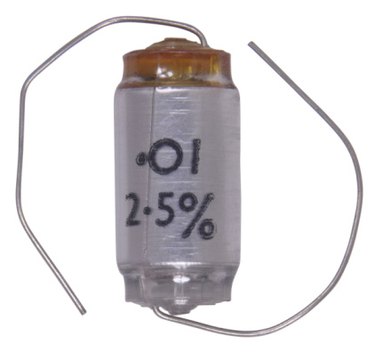
A capacitor, like any electronic part, can fail, causing problems with the device in which it is used. It stores electric charge in a thin sandwich made of metal foils separated by an insulating layer. If the insulator degrades, charges become unstable and cause a short-circuit or other electronic problems. Though any capacitor can fail, electrolytic types are most vulnerable, as the chemicals inside dry out with age.
Bulges
Video of the Day
Electronic component manufacturers cut score lines in the metal tops of electrolytic capacitors as a safety measure. The electrolyte chemical can expand if the part fails, putting the capacitor's case under pressure. The score lines allow the top to break predictably and safely rather than explode. If you see a capacitor with its top cracked open and bulging, the part has gone bad.
Video of the Day
Smoke
A bad capacitor can emit a puff of acrid, black smoke. It will coat the insides of the equipment with dark soot. If this happens, disconnect the device from the power outlet. Though unpleasant, the smoke is not harmful. It comes from electrolytic chemicals burning inside the capacitor. As the capacitor contains only a few grams of the chemicals, it makes a small amount of smoke.
Leaks
If a capacitor is poorly made, or if the circuit has excessive voltage, the chemical insulator can leak out of the bottom. The part has not only failed, it has exposed the circuit board to a mildly reactive compound, possibly affecting nearby components and the circuit board's copper foil. If you see a chemical ooze around a capacitor, it has failed.
Poor Sound
An electrolytic capacitor can fail gradually over a period of years as it dries out. The insulator in the capacitor becomes inconsistent, and its electronic characteristics drift. In audio amplifiers and related equipment, this causes problems with the dynamic range of the sound. You hear crackles in the music and it will sound weak.
Computer Malfunctions
A bad capacitor can cause a variety of mischief in computer circuits. Your computer may spontaneously restart, it may fail to start occasionally or completely. It may fail to finish the power-on self test (POST), which it performs before starting the operating system. When you turn the computer on, its fans may start, but otherwise it does nothing. While computer software problems tend to be consistent, hardware problems like this cause erratic, unpredictable behavior.